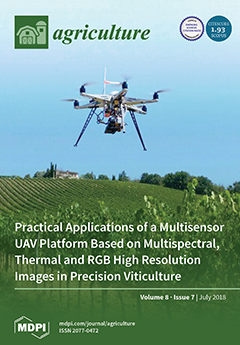A field experiment was conducted in Astaneh-ye Ashrafieh of Guilan Province in northern Iran to evaluate the environmental impact of peanut (
Arachis hypogaea L.) production under three levels of nitrogen (N) use (0, 30, and 60 kg ha
−1) applied in
[...] Read more.
A field experiment was conducted in Astaneh-ye Ashrafieh of Guilan Province in northern Iran to evaluate the environmental impact of peanut (
Arachis hypogaea L.) production under three levels of nitrogen (N) use (0, 30, and 60 kg ha
−1) applied in the form of urea fertilizer. Six categories of environmental impact (i.e., global warming potential, acidification potential, terrestrial eutrophication potential, depletion of fossil resources, potassium resources, and phosphate resources) were determined. The functional unit was assumed the production of one ton of peanut pod yield. Peanut pod yield increased by 48.8% with N rate 30 kg ha
−1 and by 108.6% with N rate 60 kg ha
−1, compared with control (without N fertilization). The environmental index (EcoX) values with regard to global warming, acidification, and terrestrial eutrophication potential were 0.18, 0.52, and 0.66 for N rates of 0, 30, and 60 kg ha
−1, respectively. Increase in N rate aggravated the emission of NH
3 and N
2O, resulting in more harmful effect of peanut growth on the environment at higher N rates than control (without N fertilization). The resources depletion index (RDI) values with regard to depletion of fossil resources, potassium resources, and phosphate resources were 0.80, 0.53, and 0.30 for N rates of 0, 30, and 60 kg ha
−1, respectively. Increase in N rate and the resultant higher peanut yield mitigated the environmental effects of fertilization mainly by reducing the depletion of phosphate resources. Proper N input is a major consideration for mitigating environmental impacts of N fertilization in crop production and producers should be informed to use the least rate that will give them an economic optimum return over the long run.
Full article





